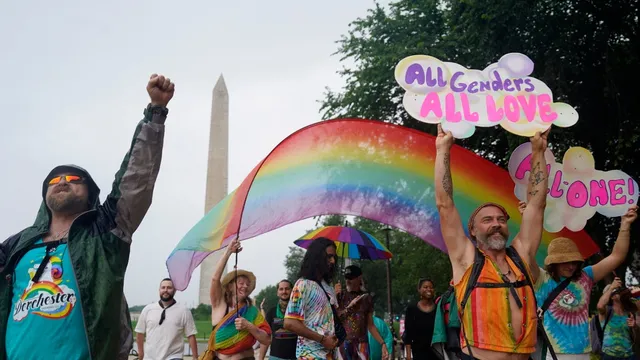
U.S. Supreme Court legalizes same-sex marriage nationwide
2025-06-28 03:22- The U.S. Supreme Court ruled in 2015 that same-sex couples have the constitutional right to marry.
- Ten years after the ruling, the number of married same-sex couples has more than doubled, but support varies by political affiliation.
- Concerns exist among LGBTQ+ advocates about potential legal challenges to marriage equality in the future.
Express your sentiment!
Insights
On June 26, 2015, the U.S. Supreme Court issued a landmark ruling legalizing same-sex marriage across the nation in a 5-4 decision. The case, Obergefell v. Hodges, marked a significant shift in American law and culture, providing same-sex couples with equal rights to marry. Before this decision, states had various laws regarding same-sex unions, creating a patchwork of legal recognition and prohibitions. The ruling was based on the principles of individual liberty and equal protection under the law as outlined in the Fourteenth Amendment, establishing that restricting marriage to opposite-sex couples was unconstitutional. The ruling addressed a long-standing debate surrounding marriage equality, affirming that same-sex couples were entitled to the same legal benefits and protections as heterosexual couples. The majority opinion, written by Justice Anthony Kennedy, emphasized that denying same-sex couples the right to marry deprives them of liberty, dignity, and recognition under the law. While 16 states had already legalized same-sex marriage at the time, the ruling unified the country's stance, requiring all states to issue marriage licenses to same-sex couples and recognize their marriages performed in other states. As of June 2025, ten years after this ruling, public opinion on same-sex marriage remains divided, particularly among political affiliations. Although support has increased overall, recent polling indicates a decline in support among registered Republicans. The conservative majority of the Supreme Court is currently considering several cases involving LGBTQ+ rights, raising concerns among advocates regarding potential legal challenges to the Obergefell ruling. In conjunction with growing public support, the number of married same-sex couples in the U.S. has more than doubled since the ruling. Despite this progress, many LGBTQ+ advocates remain vigilant, fearing backlash against same-sex marriage and related rights. The divided public opinion and certain lawmakers' attempts to revisit the Obergefell decision suggest a complex ongoing dialogue around marriage equality and LGBTQ+ protections in America.
Contexts
The landmark Supreme Court case Obergefell v. Hodges, decided on June 26, 2015, was a pivotal moment in the history of LGBTQ+ rights in the United States. This decision effectively legalized same-sex marriage nationwide, affirming that same-sex couples have the constitutional right to marry under the Fourteenth Amendment, which guarantees equal protection and due process. The ruling was a culmination of decades of activism for LGBTQ+ rights and has significantly impacted the social and legal landscape for LGBTQ+ individuals and families across the country. Following the decision, same-sex marriage became an accepted norm, leading to greater visibility, acceptance, and legitimacy for LGBTQ+ relationships within society at large. The impact of Obergefell v. Hodges extended beyond just marriage rights; it also galvanized further advocacy for broader LGBTQ+ rights. The ruling provided a legal foundation for advocating against discrimination in areas such as employment, healthcare, and housing. Many states and cities strengthened their anti-discrimination laws in the wake of the decision, recognizing the need to protect LGBTQ+ individuals from bias and inequality. Furthermore, the recognition of same-sex marriage has allowed same-sex couples to access various rights and benefits previously reserved only for heterosexual couples, thus enhancing the quality of life for many LGBTQ+ individuals. Despite these advancements, the Obergefell decision did not resolve all issues related to LGBTQ+ rights. Resistance to the ruling remains in certain regions, where state and local governments have sought to implement laws that undermine the protections established by the Supreme Court. Issues such as transgender rights, healthcare access, and religious exemptions continue to spark debate and litigation, highlighting the ongoing challenges faced by the LGBTQ+ community. The fight for equality is thus far from over, as activists continue to work toward comprehensive protections at both federal and state levels. In conclusion, the Obergefell v. Hodges decision represents a significant victory for the LGBTQ+ rights movement, marking a shift towards greater acceptance and legal recognition of same-sex relationships. While the ruling has spurred positive changes, ongoing challenges and opposition highlight the need for sustained advocacy to ensure that all members of the LGBTQ+ community receive equal rights and protections under the law. As we reflect on the decade since the decision, it is crucial to remain vigilant and proactive in the pursuit of equality, ensuring that the progress achieved is not only safeguarded but also expanded to encompass all facets of life for LGBTQ+ individuals.